Home » Gold » Gold Prospecting Tools
The Most Important Gold Prospecting Tools
Shovels, pans, dredges and other physical tools are almost useless without knowledge.
Article by: Hobart M. King, PhD, RPG
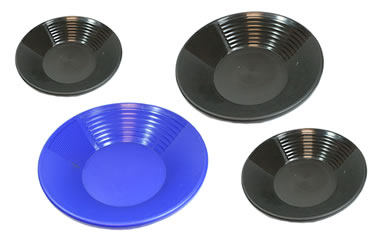
Gold pans: Most people immediately think of the gold pan as the most important tool for gold prospecting. However, a brain is required to operate it, select the right location on the stream, get permission to enter the land and decide that the land has potential. Without a well-prepared brain, the gold pan will not find very much.
Brains Are the Keys to Finding Gold
The high price of gold has inspired thousands of people to become amateur prospectors. Many of them are spending their weekends or vacations in search of the yellow metal. High gold prices have also fueled a surge in the sales of gold pans, portable dredges, metal detectors and other gold prospecting tools.
Anyone who buys these tools will not be instantly equipped to find gold. The only thing that these tools will do is help you recover the gold once you are a few feet or a few inches away from it. Getting to that location - finding gold - requires a more important tool - a human brain that has been adequately prepared with the proper types of knowledge.
The types of knowledge needed to effectively prospect for gold include:
- A knowledge of where gold has been found in the past
- A knowledge of where one can legally prospect
- A knowledge of prospecting laws and regulations
- A knowledge of gold deposits and geology
- A knowledge of prospecting methods
Here is a brief summary of the types of knowledge listed above. These summaries are brief because a complete presentation for each type of knowledge would contain enough information for at least one college-level course.
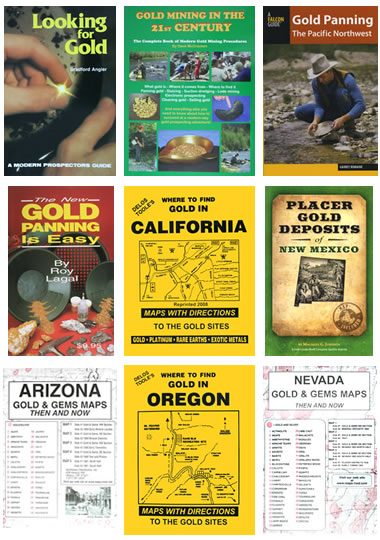
Gold Maps and Books: Books and maps that you can use to find gold have been published for many parts of the United States. These are a great starting point for anyone who wants to find gold. All of the publications above, and many more, as well as gold prospecting tools, are available in the Geology.com Store.
Where Has Gold Been Found in the Past?
The United States has been more heavily prospected for gold than most other nations on this planet. Millions of people have been mustered to the search for gold during several gold rushes in various parts of the country.
The term "gold rush" makes most people think of locations such as California, Alaska, and Colorado. However, gold rushes have also occurred in states such as North Carolina and Georgia. It is a pretty safe bet that almost any stream in the United States has been panned for gold at least once. In the most famous gold locations much of the sediment has been through gold pans, sluices or dredges multiple times.
States that have reported commercial gold production recently or in the past include Alabama, Alaska, Arizona, California, Colorado, Georgia, Idaho, Maryland, Michigan, Montana, Nevada, New Mexico, North Carolina, Oregon, Pennsylvania, South Carolina, South Dakota, Tennessee, Utah, Virginia, Washington, and Wyoming.
The state geological survey in most states with commercial gold production has prepared introductory and technical information about the gold deposits and mining history. The United States Geological Survey has prepared detailed maps and reports for most of the major gold mining areas and has prepared many general interest publications about gold. There are also lots of prospecting guides and maps written for amateur prospectors.
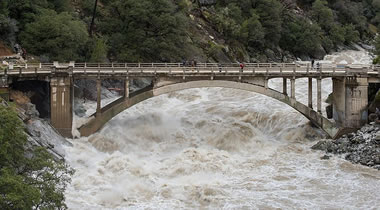
Floods Move and Redistribute Gold: Photograph of a bridge over the South Yuba River at Highway 49 after a heavy rain on January 9, 2017. The flow rate is about 25,000 cubic feet per second - over 40 times the normal rate. This type of flooding picks up gold and moves it into streams. This type of flooding reworks existing stream sediments and uncovers gold. Public domain photo by Kelly M. Grow of the California Department of Water Resources.
Hasn't All of the Gold Been Found?If the United States is one of the most heavily prospected areas on Earth, shouldn't it be a waste of time to go looking for gold? That's a reasonable question, but consider this information... Every time it rains hard enough to produce runoff, sediment is washed down hillsides and into streams. That puts "new gold" into streams. During every big flood, sediments in a stream bed are picked up, moved downstream and redeposited. This moves difficult-to-find gold to a new location, where it might be easily found. In 2017, record flooding in California thoroughly reworked streams in many parts of the state and washed lots of "new gold" into stream channels. Now a lot of people are excited about finding that "new gold". Read some field reports. |

Finders Keepers? Much more valuable than a common pebble - if you are caught removing this without permission from almost any property that you do not own, and in some cases even a property that you do own, it could result in criminal or civil problems. Learn about the Legal Aspects of Gold Prospecting. Image copyright iStockphoto / Luftklick.
Where Can One Legally Prospect?
Most of the land in the United States is off-limits for prospecting. Much of it is privately owned by individuals, corporations, institutions and trusts. Do not prospect on these lands unless you have contacted the owner and obtained explicit permission.
Explicit permission includes but is not limited to: (A) where you intend to prospect; (B) when you intend to prospect; (C) what methods you intend to use and any surface or subsurface disturbance that will result; (D) what you intend to remove from the property; (E) how anything found will be reported to and shared with the landowner. Getting these permissions is not a "courtesy" - they are a requirement. Prospecting on private property without them could result in your arrest for trespassing, vandalism or theft.
In most states, county-level governments maintain maps of property ownership that you can consult to get ownership and boundary information. Property ownership is usually public information and many local governments make it very easy for you to access it. Sometimes you can find this information online or purchase copies of the official land ownership documents. Some local governments have not invested in making this information easy to use or in keeping it current. If you decide to use this information you will probably need a good bit of mapping skill to transfer property boundaries to maps or GPS devices for easy use in the field. Good luck!
When you determine who owns a tract of land, be aware that the person who owns the surface might not own or control any minerals that are present. The mineral rights to a surface parcel are often sold or leased to someone else. So, be sure that you find out who owns the surface and who controls any minerals.
A few owners of mineral-bearing lands have opened them for "fee mining." These property owners will allow you to prospect and keep what you find if you pay them a fee before you begin or pay a fee based upon what you remove. These can be great places for a beginner to learn because prospecting there is often easy, and many of the experienced people there enjoy sharing what they know. You can learn a lot and make some great friends. These places can be a lot of fun if you are courteous to others and obey the owner's rules.
Land that is not under private ownership is usually owned by federal, state, and local governments. These lands are often off-limits to prospectors because they are being preserved as a park or conservation area. Before you go prospecting on government-owned lands you should contact the agency in charge of that land and obtain explicit permissions similar to what was described for private lands above. Removing a rock or digging on these lands can get you in a lot more trouble than on private property. Here is a quote from a Bureau of Land Management publication.
"Persons who remove mineral materials from public lands without a permit or contract are considered unauthorized users and in trespass. In addition, unauthorized users may be fined as much as $100,000 and sentenced up to 1 year in jail. This does not apply to the hobby collection of stone or petrified wood where reasonable amounts of these materials are taken without a permit for personal or nonprofit use, provided that such collection does not cause unnecessary or undue degradation."
Bureau of Land Management State Offices | |
| Alaska 222 W. 7th Ave. #13 Anchorage, AK 99513 (907) 271-5960 |
Nevada 1340 Financial Blvd. Reno, NV 89502 (775) 861-6500 |
| Arizona One North Central Ave., Suite 800 Phoenix, AZ 85004-4427 (602) 417-9200 |
New Mexico 301 Dinosaur Trail Santa Fe, NM 87508 (505) 954-2000 |
| California 2800 Cottage Way, Suite W-1623 Sacramento, CA 95825 (916) 978-4400 |
Oregon - Washington 1220 S.W. 3rd Ave. Portland, OR 97204 (503) 808-6008 |
| Colorado 2850 Youngfield St. Lakewood, CO 80215 (303) 239-3600 |
Utah 440 West 200 South, Suite 500 Salt Lake City, UT 84101 (801) 539-4001 |
| Eastern States 20 M St. SE, Suite 950 Washington, DC 20003 (202) 912-7700 |
Wyoming 5353 Yellowstone Rd. Cheyenne, WY 82009 (307) 775-6256 |
| Idaho 1387 S. Vinnell Way Boise, ID 83709 (208) 373-4000 |
National Office 1849 C St. NW, Room 5628 Washington, DC 20240 (202) 208-4800 |
| Montana - Dakotas 5001 Southgate Dr. Billings, MT 59101 (406) 896-5000 |
|
The Bureau of Land Management is responsible for 700 million acres of mineral estate lands, mostly in the western United States. A lot of commercial and recreational prospecting takes place on BLM lands. The agency is a good place to start in determining where you can legally look for gold on public land. Start by contacting the BLM state office near the location where you want to prospect. A list of their offices is in the accompanying table.
Finally, before you go into the field it is a good idea to have a map that clearly marks the boundaries of the land you are permitted to prospect. Or you might load the property boundaries into a GPS unit. Property boundaries are often unmarked in the field, and keeping track of your location while prospecting in thick vegetation or on flat open land can be challenging.
Gold panning: Gary Smith, a gold panner from British Colombia with 40 years of experience, demonstrates his panning methods and gives advice. More gold panning videos.
What Prospecting Laws and Regulations Apply?
Whenever you decide to enter public or private land and begin prospecting, it is your responsibility to know the local prospecting, land use, and environmental regulations that will apply to your actions at that specific location. Sometimes permits are needed, the methods that you use can be regulated, and there can be environmental regulations that prevent you from digging, disturbing streams, and using equipment or vehicles. Some of these have no relationship to gold prospecting, but it is still your responsibility to know and obey them.
A good place to begin is to determine the government agency responsible for administering the land that you would like to use and contact them for information. They can often provide all of the information that you need or refer you to the proper location.
Some of these areas allow prospectors to "stake a claim" that gives them temporary rights to work on a limited piece of land. If you find a valuable location you will probably want to stake a claim. It is also a good idea to learn how claims are marked so you can steer clear of them. The penalties for jumping an angry prospector's claim are unpredictable!
Learn about how to stake a claim and how to recognize claims on public land from this publication by the United States Bureau of Land Management.
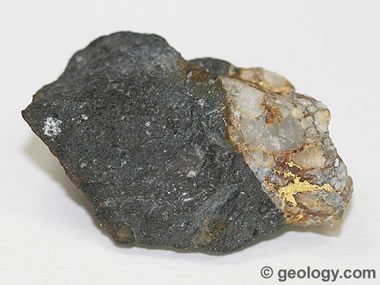
Vein gold: Vein quartz with gold attached to basalt from California. This specimen is approximately 1 inch (2.4 centimeters) across.
Gold Deposits and Prospecting Methods
Gold occurs in two basic deposit types: lode gold and placer gold. A knowledge of how these types of deposits form and where they occur is essential for finding gold. Knowledge will multiply your chances of success. There are many books, websites, and government reports that describe gold deposits and how to look for them.
A knowledge of prospecting methods is also essential. If you are on a stream that contains placer gold but you don't know how to pan then you will miss the gold right under your feet. Learning about the types of tools available and how to use them is essential for success. Again, there are many books, websites, and government reports that describe these methods.
| More Gold |
 |
Fool*s Gold |
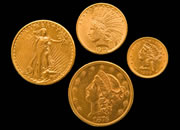 |
What is Gold? |
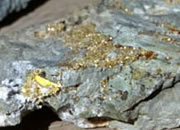 |
Gold Prospecting |
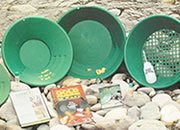 |
Gold Pans and Panning Kits |
 |
Uses of Gold |
 |
Gold |
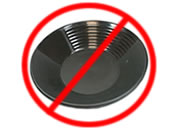 |
The most important gold prospecting tool |
 |
Gifts That Rock |

Find Other Topics on Geology.com:

|

| ||

|

| ||

|

| ||

|

|
